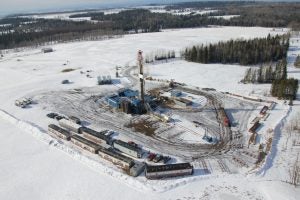
Methane a potential blind spot for Canadian oil and gas industry, says investor
While a growing number of global oil and gas companies step up to reduce methane emissions, many operators in Canada have hesitated to take concrete action, perhaps waiting instead for federal and provincial regulations to address the issue.
EDF’s Sean Wright recently sat down with Jamie Bonham, Manager of Corporate Engagement at NEI, a Canadian investment firm based in Toronto with $6 billion in assets under management. Bonham is concerned many Canadian operators do not understand the full scope of their oil and gas methane problem, but says there is considerable opportunity for Canadian companies to exert leadership.
Sean: What have your engagements with oil and gas companies on methane been like recently? Do you note any differences between Canadian and U.S. companies?

Jamie: Engagements on the topic have been positive in one sense – investors have identified methane as a material risk to the industry, and there hasn’t been any pushback from industry on that point.
But it seems evident methane might be a fairly significant blind spot for the industry. The more I talk to companies, the more clear it becomes that industry doesn’t have a good feel for the full scope of the problem. That is partly why you see pushback from the Canadian Association for Petroleum Producers (CAPP), which wants more R&D invested in measurement before addressing the problem. There is some validity to this approach, as very few players today know exactly where their methane is coming from in their operations.
As for differences between Canadian and U.S. companies, when you’re talking to actual leaders on the issue, there’s no real difference. Leaders typically don’t rely on compliance or regulations, and aren’t as buffeted by the winds of political change. That said, there is an alarming sense of complacency from some of the Canadian operators. The attitude is “we’re doing just fine, it’s just the case of a few minor tweaks and increasing paperwork and this problem will be solved.”
This outlook is a little alarming when compared to the U.S. (and internationally), where you have some industry leaders stepping up and making bold methane commitments. The absence of any Canadian players making similar commitments is noticeable.
Sean: It’s interesting what you said about methane being a blind spot in Canada? Why is that the case?
Jamie: Part of it has to do with a sense of regulatory superiority on the Canadian side. When you talk about methane, this isn’t necessarily true. But, if you broaden regulations to talk about carbon regimes – there aren’t any in the U.S., whereas certain Canadian operators have been adhering to carbon regulations for a long time. Combined with the current pullback on regulations from Washington, Canadian companies feel, possibly incorrectly, that they are operating under stricter regulations. Operators also feel that the industry is different in Canada, and thus a different approach is warranted. There is some merit to this sentiment because the markets have different geologies and oil and gas production challenges, but complacency on the scope of the challenge in Canada is still an issue.
It’s a Canadian strength and weakness – we can be conservative, and avoid serious pitfalls, but sometimes it means not necessarily being at the forefront of innovation and missing opportunities. The mindset of “as long as regulations are met, we are doing our best” is not uniquely Canadian, but it’s common among Canadian companies.
Sean: Some Canadian operators report their emissions as being down, even as multiple, peer-reviewed scientific studies show emissions are much higher than what industry reports. How are investors squaring the differences between reported information and measurements?
Jamie: I would say it’s a fundamental challenge, which is why some form of regulatory intervention on measurement and reporting is needed. As it stands now, the lack of data and collective reporting makes it difficult for investors to know exactly what is happening.
The studies you reference were not company specific, and it’s feasible that the reported reductions from companies are real, but because the total level of emissions has not been captured, it’s difficult to see the big picture. It’s important to acknowledge the reductions shown on the books are the result of capital spent and real programs designed to cut emissions. Whether or not it’s a reduction, in the sense of unreported and unmitigated emissions, is the larger question.
Companies are doing real things, but if you don’t know what your emissions are, how do you know if you’re doing the right things? The Canadian industry’s position on methane reflects this viewpoint, by pushing on measurement to determine accurate emission levels before making commitments. There’s no question a measurement gap exists, and hopefully, regulations will address the lack of reporting and data. But there is plenty of opportunity to reduce methane right now.











